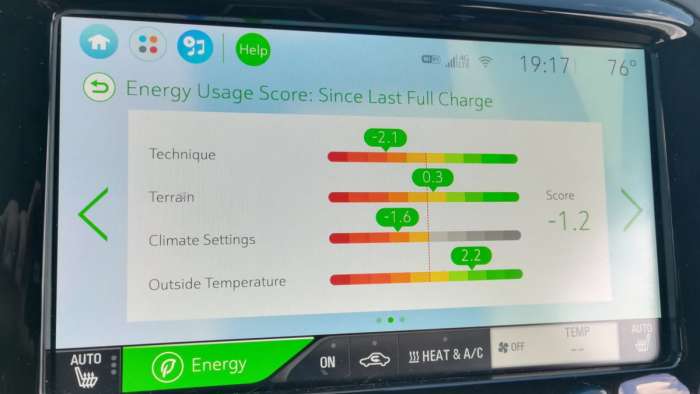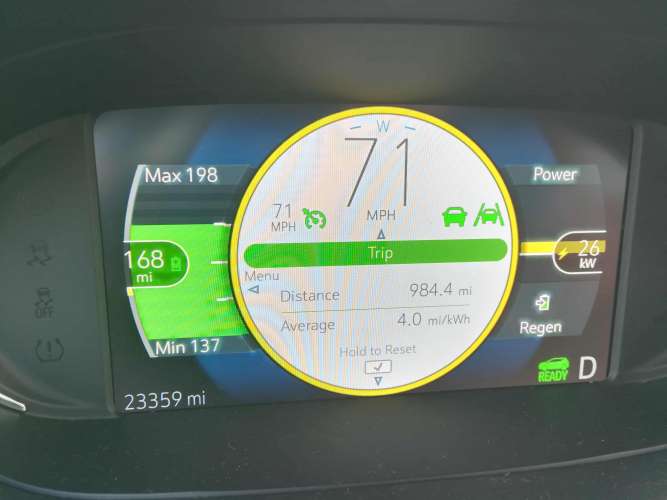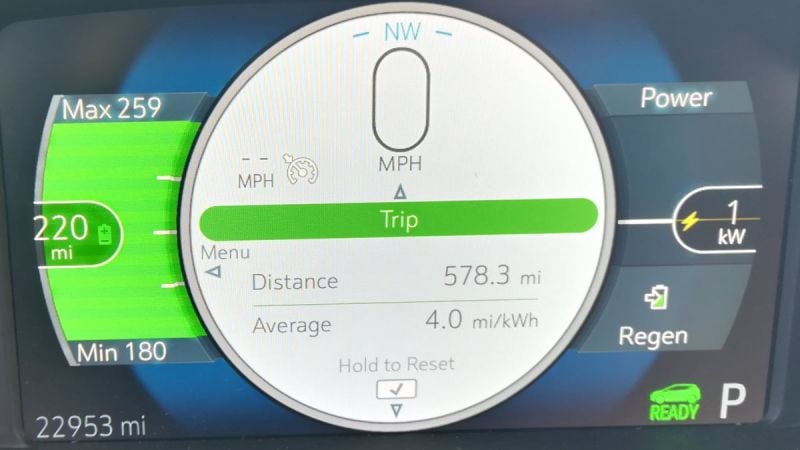For the latest model year of its first long-range, all-electric car, GM has bumped the Bolt EV’s capability up to 259 miles on a single charge. We’ve already covered why that might not be enough of an improvement to keep it ahead of the pack for long, but as any EV enthusiast will tell you about range estimates: your mileage may vary (YMMV).
From driving style and seasonal conditions to ambient temperature and elevation changes, various factors affect the real-world range you’ll see from an electric car – any car, actually, but we’re so used to the wasteful nature of gasoline vehicles that we pay it no mind.
The new 259-mile estimate represents a 9% increase on the previous average of 238 miles, but that doesn't tell the whole story. When it comes to real-world driving, what kind of distances can new owners expect to see from the 2020 Chevy Bolt EV on a single charge?
Based on my experiences in a 2017 model over 2.5 years and every season North America has to offer, here’s what I’d expect to see.
Seasonal Range Expectations in a 2020 Chevy Bolt EV
The biggest change that EV owners see in their range comes courtesy of seasonal changes.
At the height of summer, it’s not unusual to see the so-called guess-o-meter (GOM) on a Chevy Bolt EV predict well above 300 miles if you’re driving around town (more on that later). Come winter, however, that’s going to drop below 200 miles for owners in colder parts of the country, as we experience here in New England. The middle point of those two extremes is where the EPA estimate of 238 miles for 2017-2019 Bolt EV models comes in.

For the 2020 Chevy Bolt EV, we can translate the losses and gains of previous model years and extrapolate some range predictions. These estimates obviously need to be followed up with real-world testing, but they should come in useful for prospective buyers who want to know roughly how a 2020 model will perform in colder climates.
Winter: 198 miles per charge (based on 3 miles per kWh)
Spring: 257 miles per charge (based on 3.9 miles per kWh)
Summer: 304 miles per charge (based on 4.5 miles per kWh)
Autumn: 251 miles per charge (based on 3.8 miles per kWh)
In terms of percentages, these estimates amount to a 24% decrease on the EPA estimated range in winter and a 17% increase during the summer months.
These estimates are based on sample data from both my experiences in Massachusetts and other current Bolt EV owners in similar climates, who experience the extremes of all seasons. Note that in harsher winter locations, such as the most northern regions of the United States and up into Canada, range losses can be closer to 30-40% depending on extreme lows and constant use of the heating system. Nonetheless, even in the worst-case scenario it might still be possible to see as low as 165-170 miles from a 2020 Bolt EV.
The Bolt EV’s resistance heater typically draws around 6 or 7kW of power, so it’s a significant drag on overall efficiency when running constantly. For contrast, the A/C draws 1 or 2 kW and has a much smaller impact on overall range. On a 2,000+ mile road trip through Eastern Canada this past summer, for example, we ran the A/C almost constantly and still maintained 4 miles per kWh at highway speeds, putting overall range at 240 miles. In a 2020 Chevy Bolt EV, this would equate to an excellent 264 miles.

Driving Style Variations and Impact on Range
Having established potential seasonal variations, we then need to examine how driving style impacts range.
Because the Chevy Bolt EV has a tall form factor, it’s drag coefficient of 0.308 is higher than sedans like the Tesla Model 3 and Hyundai Ioniq, which are around 0.24. Although this makes it less efficient at high speeds, it can still hold its own around the upper speed limits on most North American roads. As I mentioned above, we averaged more than the 2017 Bolt EV’s EPA range on our summer travels, despite most of the journey hitting highway speeds of 70mph or more and the A/C blasting.
On a typical highway trip starting with a full charge, we budget around 200 miles for the first leg and typically arrive with 10-15% state of charge remaining. By contrast, most of our local driving occurs on roads that top out at 40-45mph, which is where we start seeing close to 5 miles per kWh and 300+ miles on a charge in the warmer months.
Watch us attempt to hit 300 miles on a single charge in a 2017 Chevy Bolt EV in the video below (Please subscribe to Torque News YouTube Channel for daily automotive news and analysis).
Then there’s how you drive, which can impact range almost as much as where you drive the Bolt EV.
With instant torque available, it can be tempting to have some fun and pound the accelerator at every stoplight. More fun, but less efficient. Pulling away with restraint, coasting where appropriate, and maximizing regenerative braking in stop-start traffic all count towards getting more from the battery capacity and bringing up your numbers.
Our style lies somewhere in the middle, keeping up with quicker traffic at highway speeds but rarely playing the stoplight dash on local roads. Based on that style, here’s what we’d expect to see from the improved 2020 Chevy Bolt EV on highway and local roads in every season:
Winter: Highway - 185 miles | Local – 215 miles
Spring: Highway - 244 miles | Local – 290 miles
Summer: Highway – 250 miles | Local – 320 miles
Autumn: Highway – 241 miles | Local -278 miles
It’s important to remember that the driver has a lot of control in terms of achieving and exceeding these estimates. Adjusting speed, driving style, and how you use climate controls all factor into your overall efficiency numbers you’ll observe. Play around with different approaches on your regular trips to learn how changes give you higher or lower numbers. We’re still waiting to see if the 2020 Chevy Bolt EV will see any significant software updates, but the Energy Usage screens in previous model years give plenty of useful data to monitor your performance.
Terrain and Elevation
One final factor to consider when you plan a Chevy Bolt EV road trip is the kind of terrain you’ll encounter and elevation gains along your route.
In terms of terrain, there’s not too much to say. The Bolt EV is a capable vehicle with decent road clearance, but you probably won’t plan to spend elongated periods driving on dirt roads. If you do, please share the efficiency data as we’d love to see it!
The most adverse conditions you’re likely to encounter on trips in the Bolt are wet or snow-packed roads, which again detract from efficiency and limit the range you’ll achieve on a single charge. In winter, you’ll already be planning more conservatively due to lower temperatures, so extend that caution to assessing the state of the road you intend to drive. Perhaps the greatest range loss in this category will come if you need to switch to winter tires, at which point it's time to reset expectations, as EPA estimates - and those in this article - are based on the Bolt EV's stock low rolling resistance tires (Michelin Energy Saver A/S Selfseal in 215/50R17).

Elevation is more of a known quantity, as you can use tools like Google Maps (in bike mode) or A Better Route Planner to quantify the hills and mountains you’ll come across. A rule of thumb for Bolt EV drivers is to allow an extra 1.5kW consumption for every 1,000ft gain in elevation, while also keeping in mind that on the descent, regenerative braking pulls back some of the losses you’ll experience on the way up.
Overall, it will be interesting to see how the 2020 Chevy Bolt EV delivers in terms of range and performance. GM says that its engineers squeezed the increased capacity of the 2020 model through improvement in cell chemistry, meaning the pack isn’t any heavier and driving dynamics should remain similar to previous model years.
What any road tripper is waiting to see, of course, is whether or not the 2020 Chevy Bolt EV charges any faster than its predecessors. For that, we’ll have to wait until deliveries begin later this year and electric vehicle pioneers start putting the car through its paces!
Stay tuned to the Torque News EV column for more on electric vehicles and my next story on how to prepare for winter in a Chevy Bolt EV.
Steve Birkett is an electric vehicle advocate at Plug & Play EV. You can follow him on Twitter at @Plugandplayev, Instagram and Youtube at Plugandplayev Channel to send him EV news tips.












Comments
We topped off Saturday night
Permalink
We topped off Saturday night/Sunday morning early October in a new '19 Bolt at 299 miles indicated. Using the left paddle for braking in all suburban driving, we're averaging about double the miles used vs. consumed.
Recently pulled fuse 34 (Pedestrian warning) and will probably disconnect the DRLs. Using auto headlights, manual heating controls to avoid compressor use. Very happy with quiet, stress free operation, rear seat room.